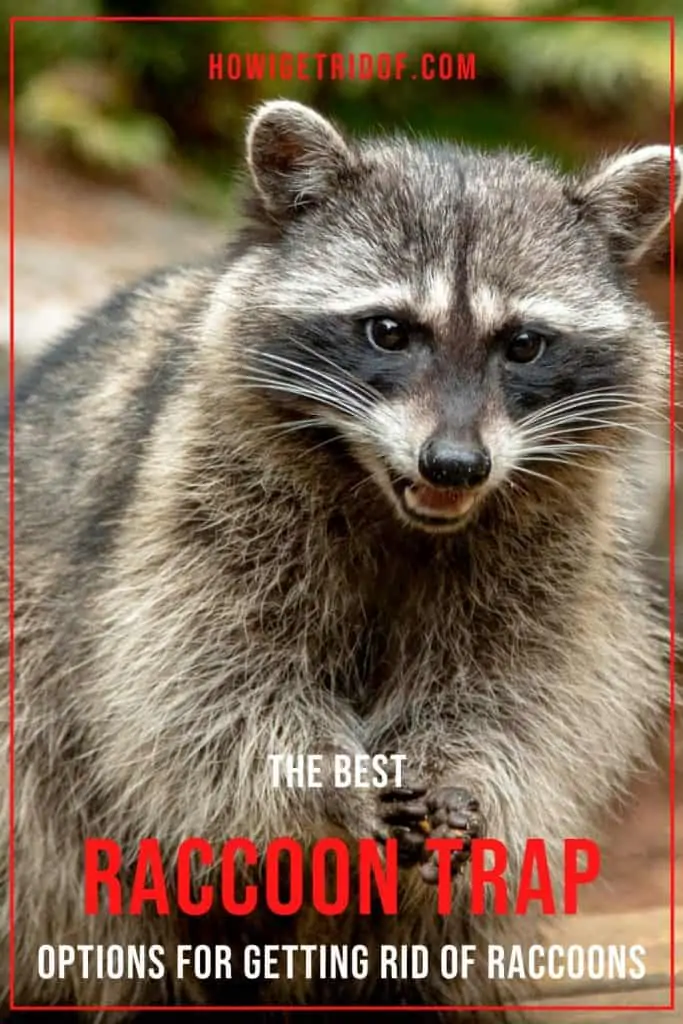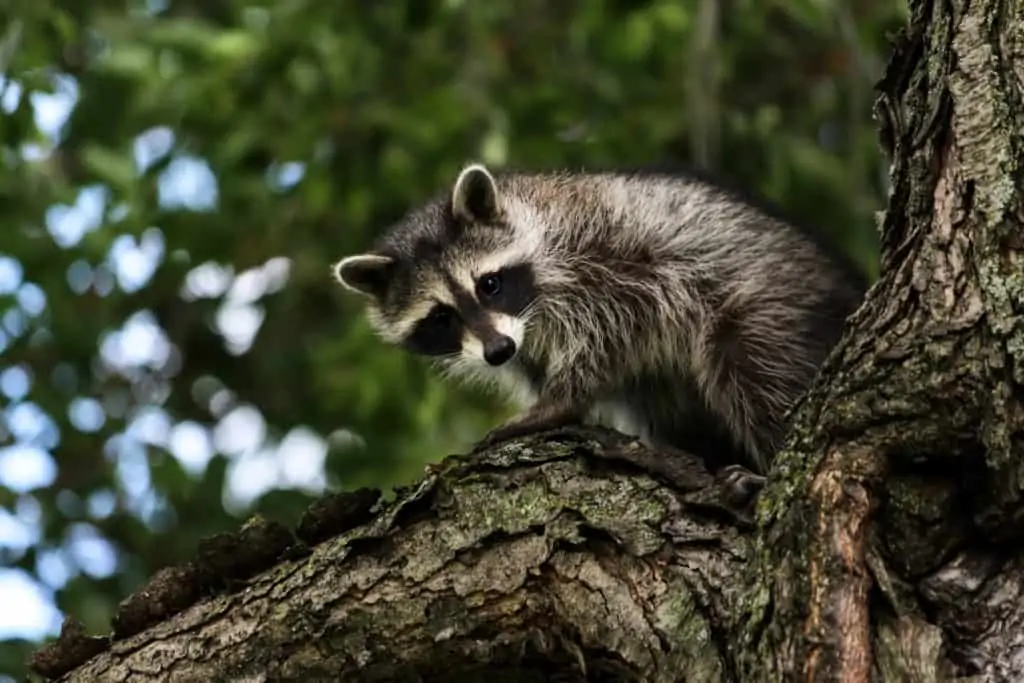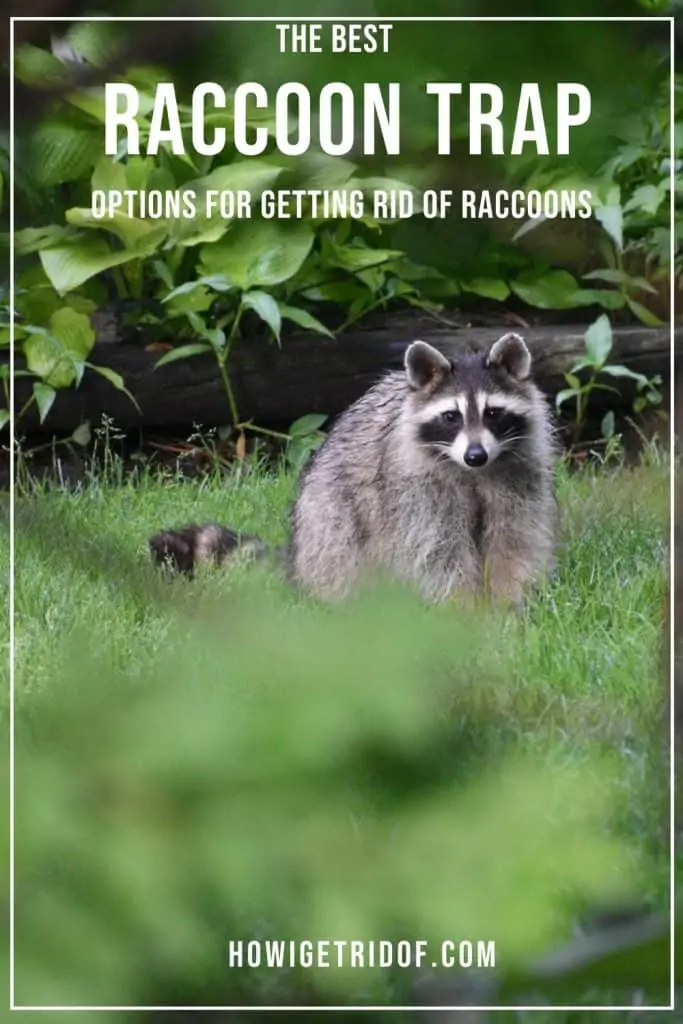Raccoons are often considered pests in many regions throughout the United States. They are messy little scavengers that tend to hang around the same places humans do in the hopes of scoring a quick meal.
Still, while many people see raccoons as a nuisance, others point out that these animals are an intricate part of a healthy ecosystem.
Furthermore, in some areas raccoons are even protected.
So, what do you do if you have a raccoon on your property or nesting in your attic, basement or crawl space?
Many people turn to a raccoon trap to solve the problem. Unfortunately, a raccoon trap is only a temporary solution to raccoon invasions, which is why we’re glad you found yourself here.
Today, we are going to talk about some of the best raccoon trap options, but we’re also going to talk about alternatives to using raccoon traps that may be more effective in the long run.
Contents
But First, Let’s Talk A Moment About Raccoons
Raccoons are native to America and while often considered pests, they are beneficial to a healthy ecosystem.
Raccoons are native to the United States and live most everywhere except for a few southwestern states and some regions of the Rocky Mountains. This means that they are abundant both in urban and suburban environments.
Like many nuisance animals, raccoons are opportunistic feeders. They are omnivores, which means they eat both plants and meat. They commonly eat insects, rodents, fish, crab, and other small animals, making them an important part of population control in the ecosystem.
Raccoons are also a prey source for other, larger predators like bobcats, mountain lions and even coyotes from time to time.
Though they do have many predators, raccoons are cunning and intelligent animals. They live together in family units of up to five raccoons at a time, which allows them more protection from predators but can also make them even more of a nuisance to people.
Worse, raccoons tend to be attracted to households, especially homes with open garages, unsealed outdoor garbage bins, or families with pets that tend to leave pet food outside in the open.
While many people find raccoons interesting and even cute, there are dangers involved with having raccoons living on your property.
First and foremost, raccoons are common carriers of rabies and other serious diseases. They also carry fleas and ticks, which can transfer to your yard and get on your pets.
These animals can also be quite destructive. They are nocturnal, and are often the culprits of dumped garbage bins in the morning.
Like most pests, raccoons need three things in order to survive – food, water, and shelter. Because they are omnivores, finding food is relatively easy. They will eat almost anything they can get their paws on, including garbage, rotten vegetables or fruits from gardens, fish out of ponds, frogs, lizards, rodents, and pet food, as we mentioned above.
This means it’s super simple for a raccoon to become problematic around your home if you do anything like, well, eat and put your garbage outside for the trash collectors. (And that’s basically all of us).
In other words, raccoons can be and often are a common problem for many people. They are especially problematic when they find their way into your home and build their den in your attic, crawlspace, basement, below your flooring or inside your walls.
Worse yet, sometimes removing and relocating raccoons is illegal. So, how do you get rid of raccoons using a raccoon trap?
We’re glad you asked. Keep reading to learn why the process may not be as simple as you think.
What You Should Know About Raccoons Before Setting Up A raccoon Trap
Relocating raccoons is often considered illegal in many regions.
Investing in a raccoon trap seems like a simple and inexpensive solution to your raccoon invasion, especially on paper. Plus, it’s easy to find raccoon traps almost anywhere, including both online and at most pest control stores.
However, ask any expert and they will tell you that using a raccoon trap to capture and relocate a raccoon is just a temporary solution. Furthermore, it may be illegal in your region.
Furthermore, even if you manage to trap and relocate the pesky raccoon and take him far enough away so he does not find his way back, other raccoons in the area will quickly fill his place.
We should also note that relocating raccoons is, surprisingly, often not the most humane way to get rid of the pests.
Raccoons are very territory oriented, and they have a strong sense of their area and home. Relocating a raccoon is often a death sentence, which can be devastating to learn if you’re trying to do the humane thing by getting rid of a raccoon using a live raccoon trap.
The truth is, raccoons tend to live their lives in one area. They learn this area and build their family units in this area. They also become protective and territorial, keeping other raccoons outside of their unit at bay.
When you relocate a raccoon to another area, you are putting him in an entirely new world where he has to compete with other “local” raccoons. More often than not, relocating a raccoon is often a death sentence.
Furthermore, many people accidentally relocate mother raccoons far from their babies (also known as kits) which in turn leaves those infants to die slowly of starvation and dehydration. This is obviously very inhumane and likely not your intention if you’re looking to relocate raccoons using a raccoon trap as opposed to using lethal methods of removal.
With that being said, there are times when you’ll need to use a raccoon trap to remove raccoons from certain areas.
For example, if you have raccoons nesting inside your home, you may want to remove them before they cause too much damage. Using a raccoon trap in this instance may be the safest and most humane option, although we would recommend contacting a professional before you attempt to use a raccoon trap on your own.
If you are feeling confident in your raccoon trapping abilities, we have listed some of the best raccoon trap options available. However, again, we encourage you to do your research before investing in a raccoon tarp and consider contacting a professional to help you move forward with the process of raccoon removal.
What Are The Best Raccoon Trap Options For Catching and Releasing raccoons?
In general, raccoon traps are not recommended. However, there are times when they are necessary.
Most raccoon traps are advertised and sold as “wild animal traps” or pest traps. They come in different sizes and may advertise that they work for animals like possums, raccoons, squirrels and other pests.
However, please keep in mind that not all raccoon trap products are going to be made equally. If you are looking for the best catch and release raccoon trap, be sure you look for a trap that is made with safety in mind for both you and the animal.
When it comes to raccoons, you never can be too careful. Remember, these animals carry serious diseases and a bite or even a scratch could mean an emergency trip to the hospital.
For this reason, it’s best to look for a sturdy raccoon trap made with quality materials and that allow you the ability to transport this trap without putting your hands directly on it. Traps should have a handle and safety shield so the animal cannot bite or scratch you through the wires.
You should also look for a raccoon trap that will not harm the raccoon inside of it. Look for traps that are smooth inside so the animal will not become cut or injured, especially once it is first trapped and panicking.
And, of course, before you trap or relocate a raccoon from your property, do your best to make sure the raccoon is not a mother raccoon that has recently had kits.
To help you gauge when you might run into a mother raccoon or kits, keep in mind that raccoon kits are typically born between March and May, with mother raccoons birthing between two to five babies per litter.
If you do suspect you have a family of raccoons nesting on or near your property, we recommend you forgo using a raccoon trap to capture and relocate them and instead contact a professional for some sound advice as to how to proceed.
On the other hand, if you believe you’re only dealing with a single or a few adult raccoons, and if you’ve done your research and are confident that capturing and relocating a raccoon in your region is the most humane and legal option, then we want to help.
Here are a few of the best raccoon trap options available for this type of work.
Havahart Animal Trap
No products found.
When it comes to live animal traps for catch and release purposes, we would recommend a raccoon trap like the one by Havahart traps above. This trap is ideal for animals about the size of raccoons and also works for capturing stray cats, possums, and even fox or small bobcats (though we wouldn’t recommend this).
The trap is made with quality material and includes a safety shield above the handle for safer transportation and relocation.
The trap is spring loaded and there are two entry points, making it easier to capture the pests and impossible for the pest to escape once he is captured.
The product is also designed for the animal’s safety as well, and there are no sharp edges on the inside that could potentially harm the raccoon when you are transporting him.
HomGarden Humane Catch and Release Trap
No products found.
Another raccoon trap that is humane and effective when it comes to capturing raccoons is the above catch and release trap by HomGarden. This trap is again designed with both the animal’s safety and your safety in mind.
The inside of the trap is smooth and will not injure the frightened raccoon during transfer. The trap also contains a safety shield near the handle so you can lift and transport the trap safely with the animal still inside.
This trap is also made with rust-resistant materials and is spring loaded, meaning it will quickly and effectively capture the nuisance animal and keep it contained.
SmartxChoices Live Animal Trap
No products found.
Last on our list for best raccoon traps would be the SmartxChoices Live Animal trap. Like the other two traps on this list, this catch and release raccoon trap is designed with a spring loaded trap door that works quickly to capture animals lured inside.
It has all the features we recommend for a quality raccoon trap, including smooth edges on the inside, a safety shield near the handle, and quality made materials that will ensure the animal is safely and effectively contained until release.
Alternatives To Using A raccoon Trap To Remove Raccoons
Sound and light repellers can work to keep raccoons from seeing your property as hospitable.
Capturing and relocating raccoons using a raccoon trap is not necessarily considered the best method. For that reason, we are listing some other alternatives you can use in place of traps that have been found to work with more success.
The good news is that there are a few ways you can go about encouraging raccoons to vacate your property without putting yourself or the raccoons in danger by using a raccoon trap.
Some of the most effective methods for how to get rid of raccoons, according to experts, are listed below.
Broox Solar Animal Repeller
No products found.
Raccoons are brazen and adaptable, but they are also sensitive to bright lights and certain sounds. One of the best ways to help repel them and keep them from building dens on your property is to use lights and noise to your advantage.
An animal repeller like the Broox Solar Animal Repeller listed above uses both of these elements to repel not only raccoons but also stray cats, rabbits, skunks and more.
We like that this solar animal repeller is motion activated and powered by the sun, so it’s as easy as setting it and leaving it. It also releases ultrasonic sounds and vibrations that are irritating to animals like raccoons but harmless to people.
Crushed Red Pepper Flakes
No products found.
If you’re having issues with raccoons getting into your garden veggies or coming near your property to build dens, try sprinkling crushed red pepper flakes around your lawn and garden. You can also make a perimeter of crushed red pepper to keep raccoons at bay.
This is a great option to try before you invest in a raccoon trap, especially if you’re looking for something inexpensive, humane and eco-friendly.
However, we should note that crushed red pepper flakes can cause irritation to pets, so use this method with caution if you have dogs or cats that are frequently outside in your yard.
Safer Brand Critter Ridder Repellent Granules
No products found.
Critter Ridder by the Safer Brand Store is another product you can use as an alternative to a raccoon trap. This product uses ingredients that are safe for the environment but are irritating to pests like raccoons, squirrels, groundhogs, skunks and chipmunks.
Some of the ingredients include black pepper, capsaicin, and piperine. This is a humane way to repel pests as it deters them using smell and taste as opposed to chemicals or traps that could harm them.
However, like using crushed pepper flakes, the Critter Ridder granules can also be irritating to dogs and cats. Avoid using this product or something similar in areas where pets frequently play.
Raccoon Remover Eviction Fluid
No products found.
Last but not least we have the above Raccoon Remover Eviction Fluid. This raccoon repellent is the ideal alternative to a raccoon trap, especially if you’re dealing with a mother raccoon and her kits inside your home.
The product works by using scents taken from the glands of predatory animals like coyotes or cougars. The scent taps into the raccoon’s flight instinct, as they will think a predator is nearby and that they are no longer safe.
You can use this product to safely evict raccoons from inside your home, but you can also use this for outside evictions and repellents as well.
Best of all, this product is completely non toxic and will not harm raccoons or kits. However, it is a strong smelling product. Be sure to use it only as directed.
Home Remedies For Getting Rid Of Raccoons Without The Use Of A Raccoon Trap
Light, essential oils and hot peppers can help keep raccoons at bay.
For the most part, getting rid of raccoons is more about getting into good habits than anything else. Remember, these animals are attracted to food, water and shelter, so if you make your home less hospitable to them they are much more likely to choose another area to build a den.
However, if you’ve noticed that you do have raccoons denning near your property and you want to encourage them to move along without the use of a raccoon trap, there are a few home remedies you can try before you invest in the above products.
Epsom Salt
It is said that epsom salt is highly irritating to raccoons. They don’t like the feel, taste or smell and will avoid this salt at all costs. To use epsom salt to deter raccoons, try sprinkling it around your property, around vegetable gardens, beneath fruit trees, over garbage, and anywhere else you have noticed raccoon activity.
Essential Oils
Essential oils can work wonders when it comes to getting rid of rodents and insects, but it can also help to repel raccoons. Some of the best essential oils you can use in place of a raccoon trap include peppermint oil and tea tree oil.
To use these oils most effectively, experts recommend that you drop about 10 to 30 drops of the essential oil of your choice into two cups of water. Then spray this solution around your property two to three times a day to repel raccoons.
If you notice a den near your property or you have a family of raccoons living inside your walls, crawl space, attic or basement, spray this solution near vents, entry points, exit points, and all other areas you can think of to try and drive them out.
Try White Vinegar
Just as with essential oils and epsom salt, vinegar is especially repulsive to raccoons. Unfortunately, vinegar has a strong smell for humans, too. Luckily, vinegar is harmless to us and it may just do the trick to get those pesky raccoons to pack up and hit the road.
It’s worth a shot!
Cayenne Pepper Solution
Cayenne pepper is hot, so as you can imagine it is irritating to the eyes and nose of a raccoon. Using cayenne pepper to protect garbage bins, veggies, and fruits outside can help not only keep your home more clean and raccoon free, but it can even encourage current raccoons to move on in the hopes of finding easier meal sources.
Use A Radio
This is an especially good tactic to use if you have a family of raccoons nesting in or around your property. Raccoons, especially mother raccoons, will do their best to stay away from humans, light and noise.
Using a wireless radio and placing it directly in areas where you know the den is could be enough to drive the family of raccoons away for good.
Spread Ammonia
Ammonia is another strong smelling liquid you can use in place of a raccoon trap to get rid of raccoons. However, remember that ammonia can be harsh and may not only be irritating to raccoons and other pests, but also pets and people.
Use Light
Last but not least we have the use of light. Raccoons are nocturnal, which means they prefer the dark. This is especially true when they are nesting or trying to sleep. If you want to really irritate a raccoon and get it to move off of your land, try reducing as much darkness around their den as possible.
The Pros and Cons of Using A raccoon Trap – Let’s Sum It Up
Raccoon traps run the risk of separating a mother from her kits, which could mean certain death for the infants.
The use of a raccoon trap can certainly be alluring, especially if you’re dealing with pesky raccoons inside of your home. This seems like a quick fix to an otherwise aggravating, messy and potentially hazardous situation for you and your family.
The reality is, using a raccoon trap is widely discouraged by experts. This is because the use of a raccoon trap puts both you and the raccoon in danger. Furthermore, raccoon traps are only temporary solutions, as raccoons are very territorial over their region and will stop at nearly nothing to find their way back again.
If they are unable to find their way back, then they’ll just be replaced eventually by other raccoons in the area.
Remember, if you have raccoons then you likely have them for a reason. The best way to remove raccoons aside from using a raccoon trap for a quick fix is to instead remove what is attracting them to your yard.
Avoid leaving dog food, cat food or bird seed out overnight. Keep your garbage bins sealed and pick up any ripe vegetation or fruits from your garden or yard.
Implement a routine form of pest control to keep other food sources of raccoons off of your property like insects, rodents and reptiles.
It’s also a good idea to keep your yard clear of debris, clutter and buildup. Remove dead branches, cut down dead or hollowed trees, and keep your yard well-maintained. This will effectively help to reduce the shelter aspect of your home.
And speaking of shelter, be sure to protect yours from raccoons. If you have ever had a raccoon in your home, you know how frustrating it can be. Avoid the mess using wire mesh or caulk to seal any cracks, crevices or entry points that could allow raccoons to get inside your home.
Are you looking for other tips and tricks for how to keep raccoons away and alternatives to a raccoon trap?
The expert in this video explains why it’s actually more important to remove things from your property to help keep raccoons at bay than it is to add things.
And there you have it – the best raccoon trap options as well as plenty of alternatives to help you keep raccoons out of your hair.
Best of luck and thanks for reading!


Jack founded our blog after two decades of working in the pest control industry. His vast experience dealing with a wide array of pests allows him to diagnose issues quickly and get to the heart of pest problems quickly and effectively. He has serviced more than 2,000 homes over his career and there is hardly any pest situation that he has not seen before.






